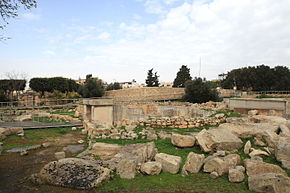Tarxien Temples

Entrance to the Tarxien Temples
|
|
| Location | Tarxien, Malta |
|---|---|
| Coordinates | 35°52′9″N 14°30′43″E / 35.86917°N 14.51194°E |
| Type | Temple |
| Part of | Megalithic Temples of Malta |
| History | |
| Material | Limestone |
| Founded | c.3250 BC–c.2800 BC |
| Periods | Tarxien phase |
| Site notes | |
| Excavation dates | 1915, 1963 |
| Archaeologists | |
| Condition | Well-preserved ruins |
| Ownership | Government of Malta |
| Management | Heritage Malta |
| Public access | Yes |
| Website | heritagemalta |
| Official name | Megalithic Temples of Malta: Ġgantija, Ħaġar Qim, Mnajdra, Ta' Ħaġrat, Skorba, Tarxien |
| Type | Cultural |
| Criteria | iv |
| Designated | 1980 (4th session) |
| Reference no. | 132 |
| Region | Europe and North America |
| Extended | 1992 |
The Tarxien Temples (Maltese pronunciation: [ˈtarʃi.ɛn]) are an archaeological complex in Tarxien, Malta. They date to approximately 3150 BC. The site was accepted as a UNESCO World Heritage Site in 1992 along with the other Megalithic temples on the island of Malta.
The Tarxien consist of three separate, but attached, temple structures. The main entrance is a reconstruction dating from 1956, when the whole site was restored. At the same time, many of the decorated slabs discovered on site were relocated indoors for protection at the Museum of Archaeology in Valletta. The first temple has been dated to approximately 3100 BC and is the most elaborately decorated of the temples of Malta. The middle temple dates to about 3000 BC, and is unique in that, unlike the rest of the Maltese temples, it has three pairs of apses instead of the usual two. The east temple is dated at around 3100 BC. The remains of another temple, smaller, and older, having been dated to 3250 BC, are visible further towards the east.
Of particular interest at the temple site is the rich and intricate stonework, which includes depictions of domestic animals carved in relief, altars, and screens decorated with spiral designs and other patterns. Demonstrative of the skill of the builders is a chamber set into the thickness of the wall between the South and Central temples and containing a relief showing a bull and a sow.
Excavation of the site reveals that it was used extensively for rituals, which probably involved animal sacrifice. Especially interesting is that Tarxien provides rare insight into how the megaliths were constructed: stone rollers were left outside the South temple. Additionally, evidence of cremation has been found at the center of the South temple, which is an indicator that the site was reused as a Bronze Age cremation cemetery.
...
Wikipedia

